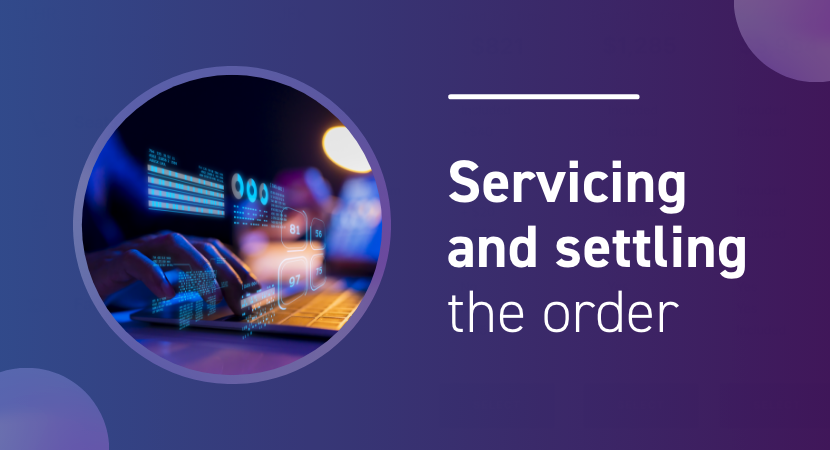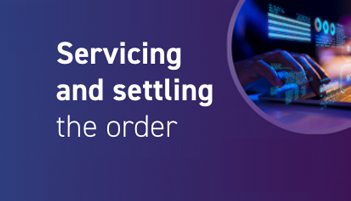
An airline has done its job—it created, distributed, and presented an offer that was purchased by a flight shopper. The offer becomes an order and everyone goes home happy, right?
Like everything else in the airline industry, it unfortunately just isn’t that simple. This is where airline order servicing and settlement comes in. Travelers need to make changes. Maybe the ticket was sold with a partner airline. There could be multiple government taxes involved that have to be calculated and paid up to the authorities.
A lot of calculations and updates have to be made after a ticket is sold. When an order needs servicing (being changed or refunded) or moves along to airline revenue accounting (settling with partner airlines or sorting out taxes), it undergoes “downstream” processes that exchange and update related data through systems that are separate from the ones that created the original offer.
Let’s break down what it means to actually go from airline offer to a customer’s order.
What does airline order servicing and settlement mean?
Once an offer is turned into an order, airlines hold unearned revenue. They have the obligation to deliver, service, and settle the order before this revenue is “earned.” Orders are intended to simplify the airline reservation, delivery, and accounting systems by gradually phasing out the current booking (PNRs) and ticketing records (e-tickets and electronic miscellaneous documents, or EMDs). When a passenger requests a change or a refund to an order today, this process relies on fare and rule conditions that are described in ATPCO Rules Categories 31 and 33. If we recall 20 years ago, almost all of these transactions had to be handled manually by an agent. Now, data coded with ATPCO makes automated changes possible. Being able to handline these requests in a fraction of the time and without manual intervention dramatically increases customer satisfaction.
Interline settlement is the process by which an airline needs to determine how much of the order revenue needs to be paid to other airline suppliers on the order. The determination of how much that portion is to be paid is determined by bilateral or industry multilateral agreements between the retailer and supplier airlines. For example, a traveler may have bought a ticket (order) from one Carrier (the retailer), but their itinerary involved a few different cities and a different carrier in order to get the customer to one of those cities. The process to determine how the retailer airline decides how much the ticket price is, and sends this money to that other carrier, is an interline settlement.
How does airline servicing and settlement work today versus in the future?
Regarding automating reissues and refunds, the airline industry has made great strides in automating these processes, yet we are still reported in some markets and channels at being around only 60 percent automation. Two of the main reasons identified for continued manual processes is either the lack of Category 31/33 data and/or the missing industry defined rules on how to reissue or refund taxes and fees.
In 2024, ATPCO is working with the industry to create default rules (system assumptions) for all airlines and we are also creating the industry’s first set of data (X3), which will provide rules on how to calculate the reissue and refund amounts of taxes and fees. These two changes alone are estimated to improve the level of automated transactions by 20–30 percent.
The future also poses some significant questions and opportunities. The industry’s ultimate goal with orders is to simplify this process and enable the retailer to re-shop all transactions and streamline the complete settlement process. ATPCO is actively working with the industry in our design teams to simplify Category 31 and 33 as much as possible to support the airlines along this journey, ensuring all regulatory requirements are met and we do not lose the automation success we have achieved.
One of the questions we will face is if an offer is created dynamically, how will its data become available in these downline systems?
ATPCO recently published a blog regarding the industry exposure of how not having the required data can result in miscalculations, increased disputes, or under collection, which results in increased costs or losses of USD 500 million annually.
As the airline industry transitions to a world of dynamically created offers from a world where all the data is pre-filed, in order not to lose the level of automation we have achieved, airlines must have a comprehensive set of data available across all their various internal systems to avoid potential revenue losses in servicing, misallocated settlement values, and competitive monitoring and fare management. Product details are a crucial piece of the pie for airlines looking to have more in-depth and complete information during these downstream processes. The industry is on a path to ONE Order but this will take many years. Until the industry has completely moved to orders, we need to find hybrid, interoperable solutions to carry us through the transition and enable accurate servicing and settlement.
How does ATPCO help service and settle the order?
ATPCO’s end-to-end solutions help bridge the gap between offer creation, management, and airline revenue accounting. Our solutions help to simplify your sales and interline settlement process so you can maximize your revenue through increased data accuracy and automation. As the airline industry’s single source of truth for data, you can audit and analyze confidently when we collect, distribute, and standardize multiple sources of revenue data on your behalf.
Here are a few ways we’re working to modernize airline servicing and settlement:
- Proration tools like PIPPS and sales data provided through the Sales Data Exchange support settlement processes. We’re partnering with ARC to migrate our Sales Data Exchange platform to AWS. By sharing infrastructure for sales data and moving to a modern, scalable platform, we can lower costs and create a comprehensive sales data lake to further support settlement and industry-wide business intelligence.
- “No touch” servicing and settlement is well underway and on track for launching in 2024. Rather than manual work required for changes and refunds, we’re working to automate pricing assumptions and with this change, expecting to increase reissues automation by at least 10 percent and increase refunds automation by at least 20 percent industry-wide.
- Creation of a new data supply (X3), which defines the calculation rules of taxes and fees in a reissue or refund transaction.
- Creation of a product catalogue data supply for supplier and retailer airlines. The catalogue will enable airlines to move to dynamic offers, will direct links to the underling traditional data (creating interoperability), and will convey the information on how to perform the interline settlement calculation for today’s settlement rules and for the new SIRSIA settlement rules of the future.
- Finding ways to support downline processes by posting, or adding, dynamic offer data into existing data streams.
Order fulfillment, servicing, and management requires the comprehensive and accurate data that ATPCO provides. As we transform to a world of dynamically created offers, support for both traditional and cutting-edge order management is needed. We’re committed to providing both the seller and the traveler more value in their flight booking process, purchase, and fulfillment than ever.



